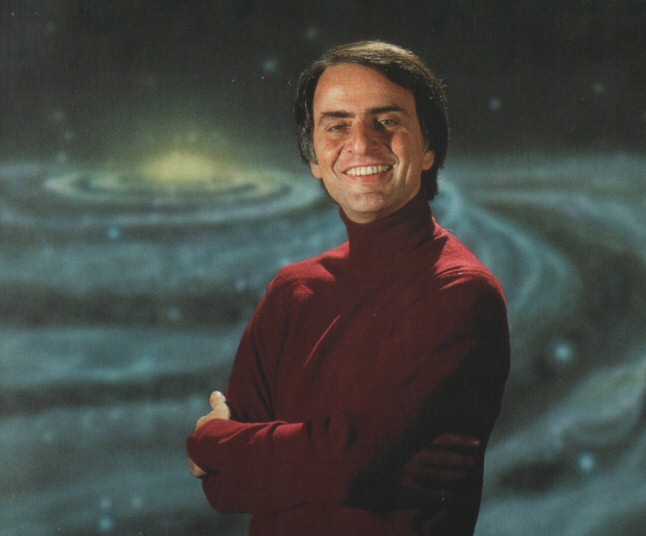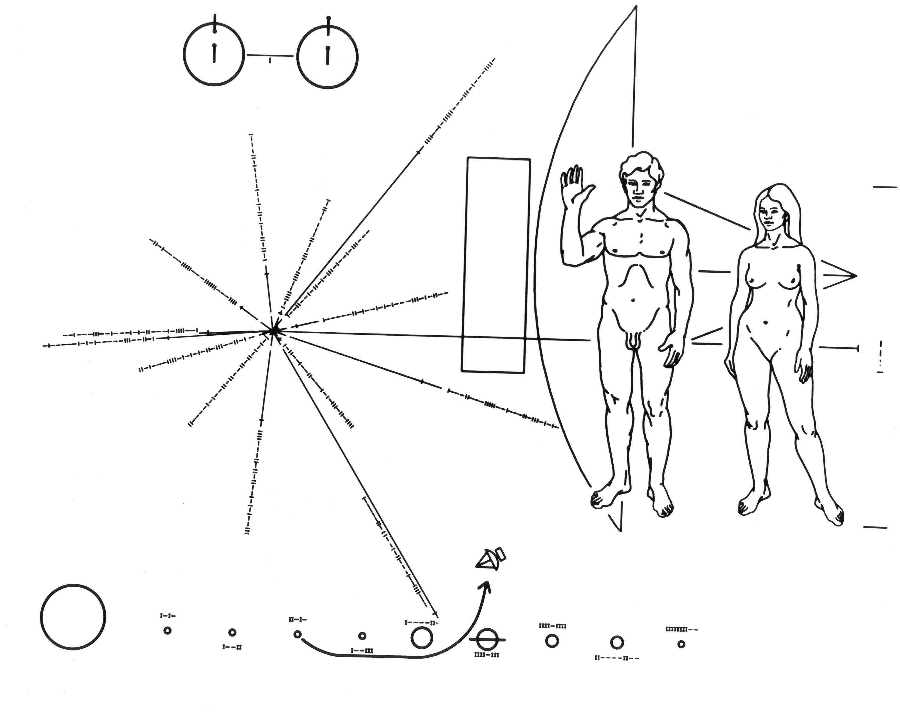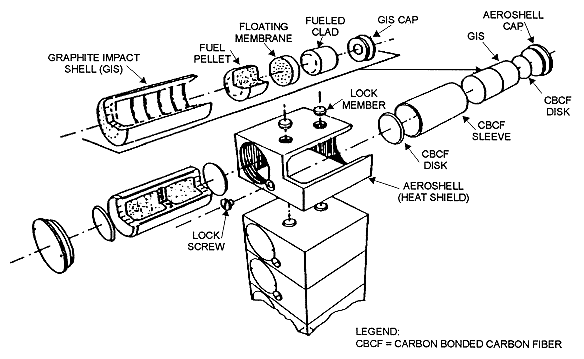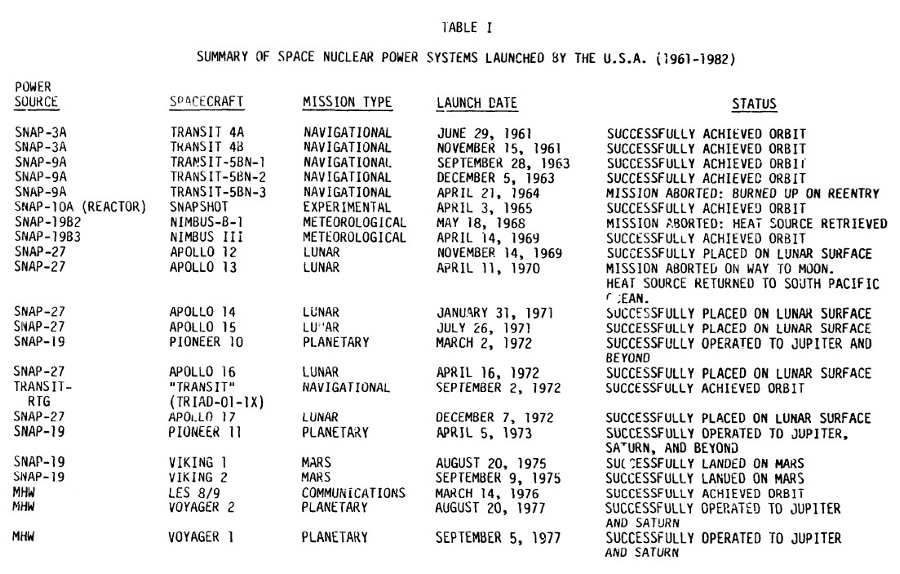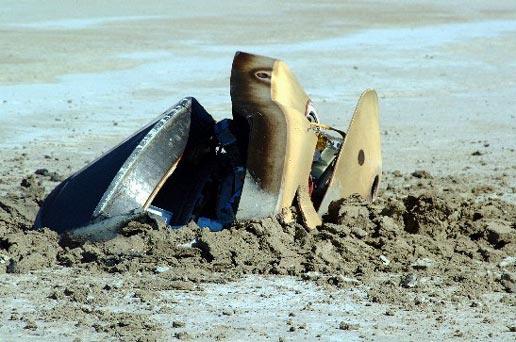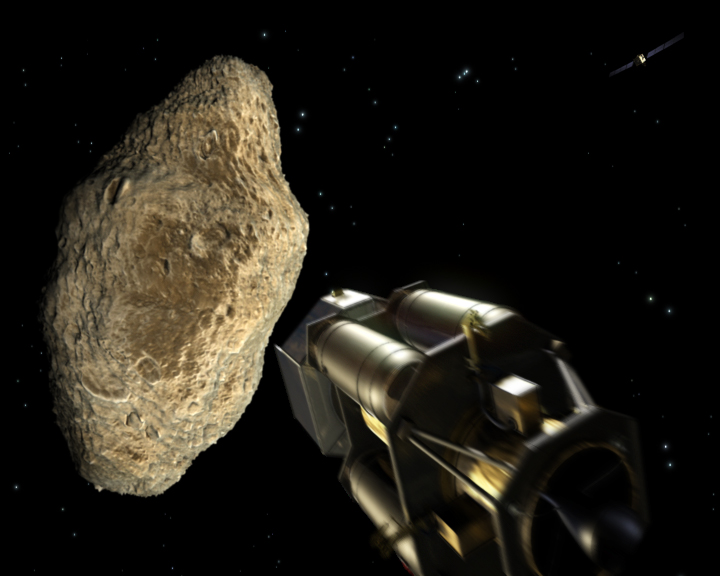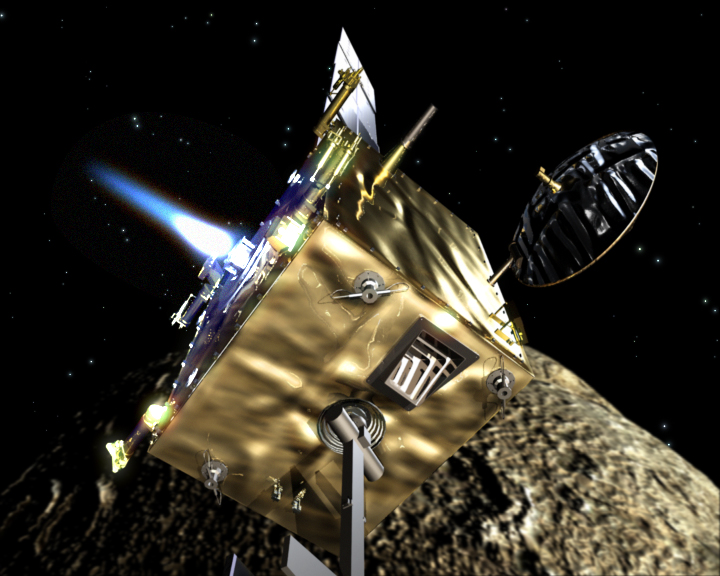|
NASA Deliberately Crashing Satellites Part Three |
||
|
..
From
Space.com
Excerpt The U.S. Air Force developed a top-secret Cold War plan to detonate a nuclear bomb on the moon in the 1950s. In a letter to the journal Nature, physicist Leonard Reiffel, leader of the effort which was called Project A 119, wrote that the Air Force wanted to explore the effects of exploding a nuclear bomb on the moons face. The Air Force wanted the explosion to be clearly visible from Earth. Reiffel wrote that the military leaders did not seem concerned with the loss to science that would have resulted from a large atomic explosion on the moons surface. Let alone what it may have done to the appearance of the "man in the moon." Part of the team researching the hypothetical explosion was a young Carl Sagan, who was recruited to study how the mushroom cloud would expand and collapse under the moons lighter gravity. Sagan proposed that a legitimate scientific purpose for the explosion could have been examining the cloud for possible organic material. Years later, Sagan apparently presented some of the results of his research on the project in an application for an academic fellowship. Reiffel believes that by doing so Sagan breached national security, as the primary secret of the project was its very existence. This breach of security was discussed in a recent biography of the astronomer, but was not detailed in that book. Striking the moon with one of the then-available Intercontinental Ballistic Missiles (ICBMs) was entirely feasible, Reiffel wrote, to an accuracy within a couple of miles (kilometers). SOURCE: SPACE.COM Nuke the Moon |
||
|
..
Carl Sagan conceived the idea of a attaching a universal
message to a spacecraft destined to leave the solar system which might
be understood by extraterrestrials that find it. He succeeded in delilvering
that message to interstellar space in the form of plaques, attached to
the space probes Pioneer 10 launched in 1972 and Pioneer 11 launched in
1973.
|
||
|
What Are RTGs? .
Image Credit: ESA What Are RTGs? RTGs are devices that use the decay of radioactive materials to generate electricity for spacecraft missions. RTGs are not nuclear reactors; they use the natural decay of elements like plutonium to generate energy. The decay generates heat, which is used by equipment in the RTG to generate electricity. Cassini uses 33 kg (72 lbs.) of largely plutonium-238, a non-weapons-grade isotope of the element. The plutonium is not placed is pure form in the RTGs but is installed as bricks of plutonium dioxide (PuO2), a ceramic which, if shattered, breaks into large pieces rather than smaller, more dangerous dust. SOURCE: Space Views |
||
|
Steve Curwood
CURWOOD: It's Living on Earth. I'm Steve Curwood. Fear gripped Australia last fall when it seemed a Russian space probe bound for Mars and loaded with a half pound of deadly plutonium might crash on the island nation. In the end, the near-panic passed as the satellite probably went down in Bolivia or Chile, and so far no traces of plutonium have been found. Today there are new concerns. This fall, NASA plans to launch its own plutonium-laden spacecraft: a mission to Jupiter, and this one carrying 72 pounds. I asked John Pike, space policy director of the Federation of American Scientists, about the risks involved with this mission, and why NASA needs a nuclear generator to power it. PIKE: Traditionally, NASA has been of the view that when they're flying missions to the outer planets, much further away from the sun than the Earth is, that solar power just isn't an option that far away from the sun. They use the plutonium on Cassini not the way you build a bomb or build a reactor here on Earth, but basically from the natural decay of the plutonium. That gives off a lot of heat. And they use thermocouples, which in turn generate the electricity that's required to power the spacecraft. CURWOOD: The concern comes from people saying that an accident could disperse this probe's plutonium into the Earth's environment. How would that happen and how likely is that? PIKE: Well, there are basically 2 major accident scenarios that people are concerned about. The first one is that the Titan rocket that it's being launched on could explode or otherwise break up shortly after launch with a radiological release around the Kennedy Space Center, Cape Canaveral Air Force Station area in Florida. The other possibility is that some time after launch, when the Cassini spacecraft loops around the sun and then comes back by the Earth in order to get a gravitational assist to get it all the way out to Saturn, there's a concern that it might be slightly off course, and rather than passing a few hundred miles above the Earth's atmosphere, re-enter the Earth's atmosphere, burn up, and the plutonium could be dispersed either over a large area or perhaps globally. The problem is that it's difficult to quantify both the probability of either of those accidents happening, or the extent to which plutonium would be released. It's fairly easy to say that the odds of the Titan rocket having a launch accident are about 1 in 20. There have been 20 Titan launches, one of them's blown up. CURWOOD: You're saying that just in the launch phase there's a 1 in 20 chance that the rocket carrying the spacecraft, which is loaded with all this plutonium, could blow up and here the plutonium might be dispersed? PIKE: Well certainly, there have been 20 Titan IV launches. One of them had a launch accident and its spy satellite payload wound up in the Pacific Ocean. And 1 in 20 is a typical number for expendable launch vehicles. NASA's calculations suggest that the radioactive power source on Cassini is built to withstand the sort of conditions that it would encounter in such an accident. Of course the problem is that they don't have an awful lot of experimental data on this. But I think that we're basically in a situation where, with a launch vehicle accident there's a relatively high probability that something's going to go wrong with the launch vehicle, a relatively low probability that the plutonium is dispersed. In the second scenario, the probability that the spacecraft swinging back by the Earth would accidentally re-enter the atmosphere is probably fairly low. On the other hand, NASA's studies conclude that if it did accidentally re-enter the atmosphere, the odds are pretty high that a lot of plutonium would get scattered around. CURWOOD: And what would that mean for people's health, for wildlife, for the planet's health if that happened? PIKE: Well, that's where the controversy comes in. NASA's assessment of the risk is that as many as a few thousand people might die as a result of Cassini re-entering the Earth's atmosphere. Other estimates place the numbers in the millions. And since we don't have very much experience with this sort of Earth fly-by, there is considerable uncertainty associated with that. CURWOOD: I'm wondering, haven't there been some pretty substantial advances in solar technology that NASA should be able to take advantage of, compared to when they first looked at the solar option? PIKE: Well, there have certainly been major advances in solar electric power technology over the last several decades. Particularly in the last 5 or 10 years, there have been significant improvements. Back in the 1960s, when NASA first started flying missions like this, I think the case for nuclear power was much clearer than it is today. The main thing that's driving the nuclear rather than solar option here is the well-founded fear on the part of the Cassini scientists that if they stopped their program for a few years, put solar power on it, that there's a real risk that NASA or the Congress would cancel it and it would never get to fly. CURWOOD: John Pike is space policy director of the Federation of American Scientists. Thank you, sir. PIKE: Thank you. |
||
|
List of Probes Carrying Plutonium .
Galileo Galileo plunged into Jupiter's crushing atmosphere on Sept. 21, 2003. The spacecraft was deliberately destroyed to protect one of its own discoveries - a possible ocean beneath the icy crust of the moon Europa. Galileo had two RTG's each carried 7.8 kilograms (17.2 lb) of Plutonium 238 Cassini carries 33 kg (72 lbs.) of largely plutonium-238 Viking Landers had RTG's... no data yet on quantity of Plutonium MSL the new rover set for Mars 2009 will have Plutonium A common application of RTGs is as power sources on
spacecraft, Systems Nuclear Auxiliary Power Program (SNAP) units were used
especially for probes that travel far enough from the Sun that solar panels
are no longer viable. As such they are used with Pioneer 10, Pioneer 11,
Voyager 1, Voyager 2, Galileo, Ulysses, Cassini and New Horizons. In addition,
RTGs were used to power the two Viking landers and for the scientific experiments
left on the Moon by the crews of Apollo 12 through 17 (SNAP 27s). RTGs
were also used for the Nimbus, Transit and Les satellites. By comparison,
only a few space vehicles have been launched using full-fledged nuclear
reactors: the Soviet RORSAT series and the American SNAP-10A. - Wikipedia
|
||
|
Crashed Spacecraft was Faster, Cheaper but not Better .
June 2006
Overconfidence in pre-existing technologies and poor management oversight contributed to the crash of NASA's Genesis sample return capsule in 2004, an official investigation concludes. The findings may help NASA improve its management of other projects, such as the successor to the space shuttle. Genesis spent 27 months in space, collecting solar wind ions thought to reflect the composition of the early solar system. But on 8 September 2004, a capsule containing the precious ions failed to release its parachutes and crashed into the Utah desert, destroying much of its contents. SOURCE: New Scientist News Services |
||
|
.
Asteroids: Treasures Of The Past And A Threat To The Future European Space Agency
Science Daily — If a large asteroid such as the recently identified 2004 VD17 – about 500 m in diameter with a mass of nearly 1000 million tonnes - collides with the Earth it could spell disaster for much of our planet. As part of ESA’s Near-Earth Object deflecting mission Don Quijote, three teams of European industries are now carrying out studies on how to prevent this. The Impact moment on the Don Quijote mission: The Orbiter spacecraft (Sancho) has retreated to a safe distance to observe how the Impactor spacecraft (Hidalgo) crashes into the asteroid. After the Impact Sancho will come closer and inspect the changes. (Credits: ESA - AOES Medialab) ESA has been addressing the problem of how to prevent large Near-Earth Objects (NEOs) from colliding with the Earth for some time. In 1996 the Council of Europe called for the Agency to take action as part of a “long-term global strategy for remedies against possible impacts”. SOURCE: ESA and Science Daily |
||
|
.
The moments before impact... The Impactor spacecraft (Hidalgo) heads towards the target asteroid. The final internal study to define the baseline specifications of the Don Quijote mission were completed in July 2005 at ESA's Concurrent Design Facility (CDF). This study was carried out in preparation for the industrial work to commence in early 2006. Several feasible cost-effective yet compelling mission scenarios were identified for the two selected targets. ESA's Don Quijote is an asteroid deflection precursor mission, designed to assess and validate the technology that one day could be used to deflect an asteroid threatening the Earth... ESA's Don Quijote is an asteroid deflection precursor mission, designed to assess and validate the technology that one day could be used to deflect an asteroid threatening the Earth... An Impactor spacecraft, named Hidalgo After following a very different route from that of the Orbiter, the spacecraft will Impact an asteroid of approximately 500 m diameter at a relative speed of about 10 km/s. This spacecraft will demonstrate the ability to autonomously hit the target asteroid based on onboard high-resolution camera. Read the whole article here.. the Don Quijote Mission Mission objectives The primary objective of the Don Quijote mission is to impact the target Near-Earth Asteroid (NEA) and to be able to determine the deflection resulting from the impact. To achieve this, it will measure with extreme accuracy the asteroid's position in space before and after impact.
The Don Quijote mission under study is based on two phases. In the first phase a spacecraft (Sanchez) would rendezvous with an asteroid and go into orbit around it, monitoring it for several months. In the second phase another spacecraft would slam into the asteroid, while the first spacecraft watches, looking for any changes in the asteroid's trajectory. If it becomes a reality, Don Quijote would launch sometime early in the next decade. SOURCE: ESA |
||
|
"Non est ad astra mollis e
terries via" - "There is no easy way from the earth to the stars."
Published: 09/25/2007 This is a documentation and study of the feasibility of creating a sustainable fusion reaction from an initial fission reaction on Saturn caused by a significant quantity of Plutonium-238 being inserted deep into the atmosphere. A fusion-ignited Saturn-sun would be the key to creating a human-habitable area on Titan. This report is the result of my intensive research on this subject since late 2002. I could not be so confident in my assertions if it were not for the additional key research of Jacco van der Worp, a Netherlands physicist, and former NASA Consultant, Richard C. Hoagland. I am sure I will be accused of being an alarmist, but I believe the information presented here will convince any open mind that there is at least some suspicious activity regarding NASA's Galileo and Cassini missions. SOURCE and rest of document: RINF Research:Lucifer Project |
||
|
.. .. Is this Possible? Many scientists say its impossible, yet others consider it... The big question is why even take the chance? There is an option to send Casinni into deep space... or just leave it there for future generations to find... and the idea of crashing it into one of Saturn's Moon's... well thankfully cooler heads prevailed and they thought that might contaminate the environment... These are what we call "Scientists"... starting before Carl Sagan wanted to Nuke the Moon... to the current "Impact Science" Nothing has changed... still big boys with expensive toys blowing things up and smashing spaceships... |
||
|
.
Question:
Answer:
SOURCE: Newton - Ask A Scientist Atmosphere:
Jupiter is a gaseous planet; it does not have a solid surface like the Earth does (but probably has a solid, rocky core 10 to 15 times the mass of the Earth). When we look at Jupiter, we are seeing icy clouds of gases moving at high speeds in the atmosphere. Jupiter's atmosphere is composed of about 90% hydrogen and 10 % helium. There are only minute traces (0.07%) of methane (CH3), water, ammonia, and rock dust. Mantle:
Pressurized hydrogen in the mantle may generate electric
currents which generate Jupiter's powerful magnetic field. The outer mantle
is liquid hydrogen; the inner mantle is liquid metallic hydrogen. The layers
of extraordinarily-compressed hydrogen are in a state so extreme that it
has never been produced on Earth. The pressure is so great that the hydrogen
molecules inside Jupiter conduct heat and electricity very well, in a metal-like
fashion (they do not do this under Earth-like condition). Inside Jupiter,
electrons from hydrogen molecules move freely from molecule to molecule
(like the electrons of a metal); this is what allows the electrical and
heat conductivity.
Core:
At the center of the planet is a molten rock core
which is many times bigger and more massive than the entire Earth. It is
20,000 °C, about three times hotter than the Earth's core.
Internal Heat:
Jupiter is a heat source; it radiates 1.6 times a
much energy as it receives from the Sun. This energy is produced by Jupiter's
shrinking due to gravity, and this produces heat. Also, it is still cooling
down, losing its initial energy (the energy it received as the Solar System
formed).
Does Jupiter produce energy by nuclear fusion -- NO. Jupiter, the biggest of the gas giants, is too small to produce a core temperature that is hot enough to undergo fusion (you need about 3 million degrees to start the fusion of hydrogen). You'd need a body that was many times the mass of Jupiter to get nuclear fusion (the theoretical limit is about 8 percent of the mass of the Sun). Magnetic Field:
Jupiter has a very strong magnetic field. The magnetic
field is probably generated as the planet spins its deep metallic-hydrogen
layer with electrical currents .
Jupiter's magnetic field (Jupiter's magnetosphere) extends for millions of miles into space. The tail of this magnetic field (which is extended by the solar wind), extends into the orbit of Saturn! A tremendous amount of charged particles are trapped within this magnetosphere, especially in the inner parts of this field. This makes Jupiter the most deadly radiation environment of any of the planets. SOURCE: Enchanted Learning |
||
|
.
The mean density of Saturn is one-eighth that of the Earth because the planet consists mainly of hydrogen. The enormous weight of Saturn's atmosphere causes the atmospheric pressure to increase rapidly towards the interior, where the hydrogen gas condenses into a liquid. Closer to the centre of the planet, the liquid hydrogen is compressed into metallic hydrogen, which is an electrical conductor. Electrical currents in this metallic hydrogen are responsible for the planet's magnetic field. At the centre of Saturn, heavy elements have probably settled into a small rocky core with a temperature close to 15,000° C (27,000° F). Both Jupiter and Saturn are still settling gravitationally, following their original accretion from the gas and dust nebula from which the solar system was formed more than 4.5 billion years ago. This contraction generates heat, causing Saturn to radiate into space three times as much heat as it receives from the Sun. The Atmosphere of Saturn Saturn's atmospheric constituents are, in order by mass, hydrogen (88 per cent) and helium (11 per cent); and the remainder comprises traces of methane, ammonia, ammonia crystals, and such other gases as ethane, ethene (ethylene), and phosphine. Voyager images showed whirls and eddies of clouds occurring deep in a haze that is much thicker than that of Jupiter because of Saturn's lower temperature. The temperatures of Saturn's cloud tops are close to -176° C (-285° F), about 27° C (49° F) lower than those of such locations on Jupiter. The movements of Saturnian storm clouds show that the period of rotation of the atmosphere near the equator is about 10 hr 11 min. Radio emissions that have been detected coming from the body of the planet indicate that the body of Saturn and its magnetosphere rotate with a period of 10 hr 39 min 25 sec. The approximately 28.5-min difference between these two times indicates that Saturnian equatorial winds have velocities close to 1,700 km/h (1,060 mph). In 1988, from studies of Voyager photos, scientists determined an odd atmospheric feature around Saturn's north pole. What may be a standing-wave pattern, repeated six times around the planet, makes cloud bands some distance from the pole appear to form a huge, permanent hexagon. SOURCE: Think Quest Saturn's Composition and Atmosphere How Saturn differs from the Earth Saturn differs from the Earth in that there is no sharp distinction between atmosphere and the planet's body. Instead there is a slow gradual change from gaseous atmosphere to liquid. The pressure increases with depth, and the hydrogen and helium gases become liquid. Thus, Saturn does not have a "surface" in the same sense that the Earth does. It would be impossible to land a spacecraft, though one could be made to drop slowly with a parachute and transmit information until the intense pressure of Saturn's atmosphere crushed it. Saturn's atmosphere Saturn's atmosphere, although similar to Jupiter's, is much less interesting to look at. It tends to have a uniform beige color, which is attributed to sulfur in the atmosphere. False color images, however, reveal bands across Saturn running parallel to the equator much like Jupiter's. Also like Jupiter violent winds whip though the atmosphere at over 1000 mph. Saturn's Composition
Saturn is approximately 75% hydrogen and 25% helium with traces of other substances like methane and water ice. Storms Storms similar to Jupiter's are known to appear, but are much more rare. Although nothing like Jupiter's well known Giant Red Spot exists on Saturn, large violent storms have been spotted by the Hubbell Space Telescope. Interesting fact Interestingly Saturn, like Jupiter, is emitting large amounts of infrared energy. The interior of Saturn is believed to be about 12000K at the center, and the planet is emitting twice as much heat into space as it receives from the sun SOURCE: Portland State University |
||
| FAIR USE NOTICE: This page contains copyrighted material the use of which has not been specifically authorized by the copyright owner. Pegasus Research Consortium distributes this material without profit to those who have expressed a prior interest in receiving the included information for research and educational purposes. We believe this constitutes a fair use of any such copyrighted material as provided for in 17 U.S.C § 107. If you wish to use copyrighted material from this site for purposes of your own that go beyond fair use, you must obtain permission from the copyright owner. | ||
|
|
